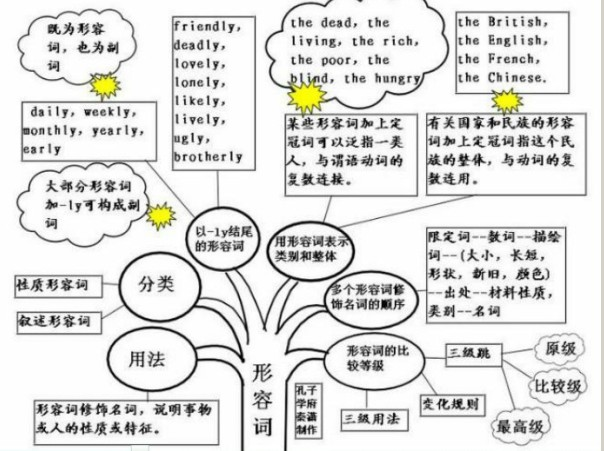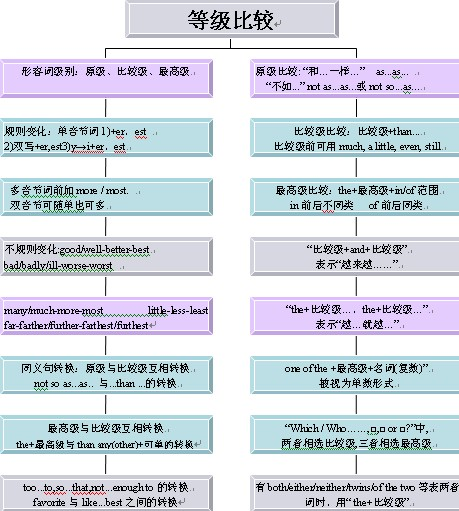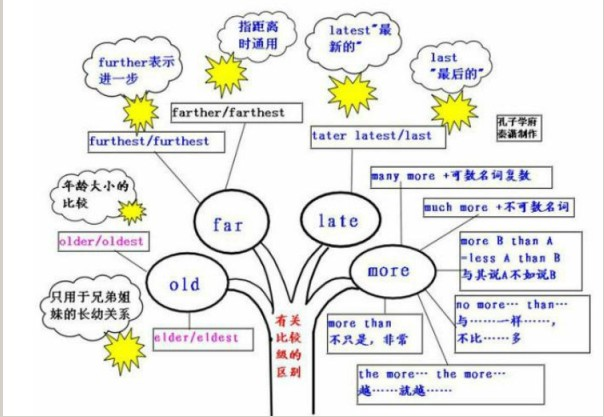形容词的概念:
形容词(adjective),简称adj.或a,形容词用来修饰名词或代词,表示人或事物的性质、状态,和特征的程度好坏与否,形容词在句中作定语、表语、宾语补足语。通常,可将形容词分成性质形容词和叙述形容词两类,其位置不一定都放在名词前面。
形容词的作用与位置:
形容词是用来修饰名词的,常被放在名词前作定语,或放在系动词后面作表语。以下属几种特殊情况,须牢记;
(1)形容词短语作定语,定语后置。
如:a language difficult to master,
a leaning tower about 180 feet high
(2)表语形容词(afraid、alike、alone、asleep、awake、alive等)作定语,定语后置。如a man alive。有些表身体健康状况的形容词如well、faint、ill只作表语。sick既可作表语又可作定语,ill如作定语意为“bad”。
(3)用作定语,修饰由不定代词one、no、any、some和every构成的复合词如anything、something等时,通常后置。
如:I have something important to tell you.
(4)else常用作疑问代词和不定代词的后置定语。
(5)enough、nearby修饰名词前置或后置,程度副词一般位于形容词、副词前面,enough修饰形容词、副词时,必须后置。
(6)几个并列的形容词作定语,其语序通常为:限定语(The、A)+描绘性形容词+size(大小)+shape(形状)+age(年龄、时间)+color(颜色)+origin(国籍、来源)+material(材料)+purpose(目的)+名词。
口诀:
限定描绘大长高,形状年龄和新老;颜色国籍跟材料,作用类别往后靠。
如:a heavy black Chinese steel umbrella,
the man's first tow interesting little red French oil paintings
形容词的用法:
1、形容词修饰名词,说明事物或人的性质或特征。通常,可将形容词分成性质形容词和叙述形容词两类,其位置不一定都放在名词前面:
1)直接说明事物的性质或特征的形容词是性质形容词,它有级的变化,可以用程度副词修饰,在句中可作定语、表语和补语。例如:hot热的。
2)叙述形容词只能作表语,所以又称为表语形容词。这类形容词没有级的变化,也不可用程度副词修饰。
大多数以a开头的形容词都属于这一类。例如:
afraid害怕的。(错)Heisanillman. (对)Themanisill. (错)Sheisanafraidgirl. (对)Thegirlisafraid.
这类词还有:well,unwell,ill,faint,afraid,alike,alive,alone,asleep,awake等。
3)形容词作定语修饰名词时,要放在名词的前边。但是如果形容词修饰以-thing为字尾的词语时,要放在这些词之后。例如:somethingnice
2、用形容词表示类别和整体:
1)某些形容词加上定冠词可以泛指一类人,与谓语动词的复数连接。如:the dead,the living,the rich,the poor,the blind,the hungry The poorarelosinghope.穷人失去了希望。
2)有关国家和民族的形容词加上定冠词指这个民族的整体,与动词的复数连用。如:the British,the English,the French,the Chinese. The English have wonderful senseofhumor.
以-ly结尾的形容词:
1)大部分形容词加-ly可构成副词。但friendly,deadly,lovely,lonely,likely,lively,ugly,brotherly,仍为形容词。改错:
如:(错)She sang lovely.
(错)He spoke to me very friendly.
(对)Her singing was lovely.
(对)He spoke to me in a very friendly way.
2)有些以-ly结尾既为形容词,也为副词。 daily,weekly,monthly,yearly,early .
如:The Times is a daily paper.
The Times is published daily.
形容词知识体系:

复合形容词的构成:
(1)形容词+名词+ed:
如:kind-hearted 好心的,white-haired 白发的
(2)形容词+形容词:
如:red-hot 炽热的,dark-blue 深蓝的
(3)形容词+现在分词:
如:good-looking 好看的,easy-going 随和的
(4)副词+现在分词:
如:hard-working 勤劳的,fast-moving 快速转动的
(5)副词+过去分词:
如:hard-won 得来不易的,newly-made 新建的
(6)名词+形容词:
如:life-long 终生的,world-famous 世界闻名的
(7)名词+现在分词:
如:peace-loving 爱好和平的,fun-loving 爱开玩笑的
(8)名词+过去分词:
如:snow-covered 白雪覆盖的,hand-made 手工的
(9)数词+名词+ed:
如:four-storeyed 4层楼的,three-legged 3条腿的
(10)数词+名词(名词用单数):
如:ten-year 10年的, two-man 两人的
相关高中英语知识点:形容词的比较级
形容词比较级概念:
大多数形容词(性质形容词)有比较级,用来表示两个人或事物之间的比较“较……”。
如:I am taller than you.
形容词比较级特殊用法:
1、没有比较对象的比较结构:
所谓没有比较对象的比较结构不是指省略而言,而是指并非真正的比较。
例如:The car runs faster than110 miles. 那辆车时速为110多英里。
There is more than one solution to the problem. 这个问题的解决办法不止一个。
The daily cost in an average hospital in the United States can run as high as $250. 在美国普通医院的每天的费用可高达250美元。
2、用比较级的形式表达最高级的意思:
在这种情况下,往往是将一个人或是一件事与其他所有的人或事相比较。注意别忘了常在比较状语中用any, other, else类的字眼,以将比较主体排除在比较对象以外,因为自己不可以与自己相比较。
例如:He is taller than any one else in our class. 他在我们班比其他任何都高。
Iron is more useful than any other metals. 铁比其他任何金属更有作用。
3、no+比较级+than的结构表示“A和B一样不……”:
例如:She runs no faster than her sister.她与她妹妹一样跑不快。
Tom is no wiser than John. 汤姆和约翰一样没有聪明才智。
He is no richer than his brother. 他与他弟弟一样不富有。
4、汉语可以说“昆明的气候比兰州好”。英语必须加that:
例如:The climate of Kunming is better than that of Lanzhou.
5、英语比较级常译作“较…”、“…一些”等,但不等于汉语的“更…”。汉语的“更…”须用“still”或“even”来表示:
如:This book is even more difficult than that one. 这本书比那本书更难。
6、有些情况下,汉语不用“较”等字眼,英语则须用比较级:
如:Will the younger people give their seats to old people? 请年轻人把座位让给老年人好不好?
形容词比较级的用法:
1、比较级用于二者的比较,其结构是:含有形容词比较级的主句+从属连词than引导的从句(从句中常省去意义上和主句相同的部分)。
如:Li is older than Zhou. 李比周年纪大。(从句中省去了is old)
There are more children in this nursey than in that one. 这个托儿所的孩子比那个托儿所多。(从句中省去了there are children)
After two years' physical training, she is healthier and stronger. 经过两年的体力锻炼,她(比以前)健康强壮多了。(注意这里省去了从句than she was)
We are much better off than ever before. 我们的生活比过去任何时候都要好得多。(than后省去了we were)
Paul weighs less than harry. 保尔的体重比哈利轻。
Mary is less clever than Jane. 玛丽不如简那么聪明。
2、可修饰比较级的词:
1)a bit, a little, rather, much, far, by far, many, a lot, lots, a great deal, any, still, even等
2)还可以用表示倍数的词或度量名词作修饰语。
3)以上词(除by far)外,必须置于比较级形容词或副词的前面。
典型例题:
1)?Are you feeling ____?
?Yes,I'm fine now.
A. any well
B. any better
C. quite good
D. quite better
答案:B. any可修饰比较级,quite修饰原级,well的比较级为better.
2)The experiment was____easier than we had expected.
A. more
B. muchmore
C. much
D. moremuch
答案:C. much可修饰比较级,因此B,C都说得通,但easier本身已是比较级,不需more,因此C为正确答案。
3)If there were no examinations, we should have___at school.
A. the happiest time
B. a more happier time
C. much happiest time
D. a much happier time
答案:D.
注:many, old和far用法:
1)如果后接名词时,much more+不可数名词 many more+可数名词复数
2)old有两种比较级和最高级形式:older/oldest和elder/eldest。elder,eldest只用于兄弟姐妹的长幼关系。
如:My elder brother is an engineer.
3)far有两种比较级,farther,further在英语中两者都可指距离。在美语中,father表示距离,further表示进一步。
如:I have nothing further to say.
3、比较级中的两个特殊作用的结构:
1)The+比较级+句子,表示的意义是“越(怎么样就)越(怎么样)”,在这个结构中的两个“比较级”不要求一定词性相同,它们各自的词性要依句子的需要而定;
2)和比较级+and+比较级。表示的意义是“越来越(怎么样)”,在这个结构中的两个“比较级”则要求词性相同。
例如:The harder you work at your study, the better academicrecords you will have. 你学习越努力,你的成绩就越好。
The more we have, the more we want. 人欲无穷。
When winter is coming, it gets colder and colder. 冬天来临之际,天越来越冷了。
He became less and less satisfied with the foot ball team's performance. 他对足球队的表现越来越不满意了。
形容词比较等级知识体系:

特殊形容词比较级变化:

相关高中英语知识点:形容词的最高级
形容词最高级概念:
表示“三者、三者以上之中之最”,用形容词的最高级句式,形容词最高级前必加冠词the。
形容词最高级用法:
1)the+最高级+比较范围:
如:The Sahara is the biggest desert in the world.
形容词最高级前通常必须用定冠词the,副词最高级前可不用。形容词most前面没有the,不表示最高级的含义,只表示“非常”。
如:It is a most important problem.=It is a very important problem.
注意:使用最高级要注意将主语包括在比较范围内。
如:(错)Tom is the tallest of his three brothers.
(对)Tom is the tallest of the three brothers.
2)下列词可修饰最高级,by far, far, much, mostly, almost :
如:This hat is nearly/almost the biggest.
注意:
1、very可修饰最高级,但位置与much不同。
如:This is the very best.
This is much the best.
2、序数词通常只修饰最高级。
如:Africa is the second largest continent.
3)句型转换:
如:Mike is the most in telligent in his class.
Mike is more intelligent than any other students in his class.
4)“否定词语+比较级”,“否定词语+so…as”结构表示最高级含义:
如:Nothing is so easy as this.=Nothing is easier than this.=This is the easiest thing.
形容词最高级用法特别提示:
1、表示“最…之一”的句式:one of the+.最高级+名词复数:
如:Jim is one of the best students in his class.
Su zhou is one of the most beautiful cities in China.
2、“the+序数词+最高级”表示“第几个最…”:
如:The Yellow River is the second longest river in China.
3、当最高级前有物主代词或名词所有格时,不加the;
如:Monday is my busiest day.
Jack is Jim's best friend.
4、比较级与最高级的转换:
如:He is taller than any other boys in his class.
He is the tallest boy in his class.
形容词最高级用法的注意点:
1)最高级后常有介词短语、从句或所有格来表比较范围。
2)最高级前有作定语的物主代词、指示代词或名词所有格等时,不再加定冠词the。
3)形容词最高级用在oneof结构中,这时最高级后面的名词要用复数。
4)形容词最高级有时单独使用,没有比较的范围。
如:Greece's best writers lived in ancient Athens. 希腊最好的作家居住在古雅典。
The most violent have winds of more than 400kilometres per hour. 最猛烈的风力达到每小时400千米以上。
5)形容词最高级前有时有定语或状语修饰。
如:Japan's second largest city is Osaka. 日本的第二大城市是大阪。
Here in Vancouver,you're in Canada's warmest part. 这里是温哥华,加拿大最暖和的地方。
Tai Lake is nearly the biggest in EastChina. 太湖在华东几乎是最大的。
6)形容词最高级有时有特殊用法。
①most同形容词连用而不用the时,表示“非常,十分”。
②当形容词最高级作表语,而又不与别的人或物作对比时,不用the。
如:The supermarket is busiest on weekend. 这个超市周末最忙。
③用作宾语补足语的形容词最高级前的the常省略。
如:We feel it most difficult to write a composition in English. 我们觉得用英语写作文最难。
I think it best not to ask him about it now. 我想现在还是不要向他询问此事为妙。
④形容词最高级还可用在某些短语中。
如:You can at least go and get your jacket. 你至少可以去拿你的夹克衫。
I guess it should only cost at most fifty dollars. 我猜想它最多值五十元。
We'll do our best to make the transportation unimpeded. 我们将尽最大努力使交通畅通。
形容词最高级变化有规则和不规则两种:
1、规则变化:
构成 | 原级 | 最高级 |
| 单音节以及少数双音节的词后面直接加-est | tall | tallest |
| short | shortest | |
| 以不发音的e结尾只加-st | large | largest |
| “以辅音字母+y”结尾的词改y为i,再加-est | happy | happiest |
| easy | easiest | |
| 以一个元音加一个辅音字母结尾的单音节词(即重读闭音节词),双写结尾的辅音字母, 再加-est | hot | hotter |
| big | bigger |
注:大部分双音节词和多音节的词(即音标中含有三个或三个以上元音音素的词),要在前面加more,most。
如:interesting→most interesting
expensive→most expensive
特别提醒:
1、以形容前缀un构成的三音节形容词不适合上述情况:
如:unhappy→unhappiest,
2、以形容词+ly构成的副词要在前面加 more,most:
如:slowly→most slowly
2、不规则变化:
原级 | 最高级 |
| good | best |
| bad/ill | worse |
| little | least |
| many/much | most |
| far | farthest/furthest |
| old | oldesteldest/ |
形容词最高级用法解密:
1、形容词最高级前必须加定冠词the,但如果最高级前有物主代词、指示代词、名词所有格等修饰时,则不用定冠词。
如:My oldest daughter is 16 years old. 我最大的女儿16岁。
2、形容词最高级常与由介词in或of引导的表示范围的短语连用。若介词后的名词或代词与句中的主语是同一事物时,则用of短语;
当只说明是在某一空间、时间范围内的比较时,则用in短语。
如:This apple is the biggest of all. 在所有的苹果中,这个苹果最大。
He is the youngest in his class. 他在他班里年龄最小。
3、形容词最高级前可用序数词限定,共同修饰后面的名词,其结构为:“the+序数词+形容词最高级+名词”。
如:Hai nan is the second largest island in China. 海南是中国的第二大岛。
4、形容词最高级的意义还可以用比较级形式表达。常见的有:
(1)形容词比较级+than any other+单数名词。
如:This is more difficult than any other book here. (=This is the most difficult book of all.) 这些书当中这本最难。
(2)形容词比较级+thantheother+复数名词。
如:Asia is bigger than the other continents on the earth. 亚洲是地球上最大的洲。
5、形容词最高级前若有不定冠词a,这时,它不表示比较,而表示“非常”的意思。
如:Spring is a best season. 春天是一个非常好的季节。形容词最高级前通常要加定冠词the,而以下几种情况一般不需要加定冠词the:
(1)形容词最高级前有序数词、物主代词、指示代词或名词所有格等限定词修饰时,最高级前不用the。
如:The Yellow River is the second longest river in China. 黄河是中国第二长河。
(2)形容词最高级在句中作表语而比较范围又不明确时,最高级前不用the。
如:They are happiest on Saturdays. 他们在星期六最快乐。
(3)如果两个形容词最高级并列修饰同一个名词时,第二个形容词最高级前不加the。
如:He is the youngest and tallest boy in his class. 他是班上年龄最小、个子最高的男孩。
(4)如果形容词最高级用来加强语气,作“十分;非常”之意时,前面不加the。但形容词最高级作单数名词的定语时,可用不定冠词a/an。
如:That book is most interesting. 那本书非常有趣。
(5)作宾语补足语的形容词最高级前不加the。
如:I found it most difficult to get to sleep. 我发现入睡最难。
(6)在一些固定用法中,最高级前通常省略the。
如:With best wishes for you. 向你致以最美好的祝愿。
相关高中英语知识点:形容词的排序
多个形容词修饰名词时,其顺序为:
限定词?数词?描绘词?(大小,长短,形状,新旧,颜色)?出处?材料性质,类别?名词
如:a small round table
at all gray building
a dirty old brown shirt
a famous German medical school
an expensive Japanese sports car
熟记规则:
大小形状和新老,颜色国籍出(处)材料。
多个形容词修饰同一名词时的顺序是固定的,其顺序为:
①冠词、指示代词、不定代词、物主代词+②序数词+基数词+③一般性描绘形容词+④大小、长短、形状+年龄、新旧+⑥颜色+⑦国籍、出处+⑧材料+⑨用途、类别+⑩最终修饰的名词或动名词。
例如:a beautiful little red flower 一朵美丽的小花。
I have a big, round, red, wooden, Chinese table. 我有一个中国制造木制红色的大的园桌子。
巧记形容词排列顺序:
限定描绘大长高,形状年龄和新老;颜色国籍跟材料,作用类别往后靠:
其中,“限定词”包括:冠词、物主代词、指示代词、或数词,它位于各类形容词前。它本身分为三位,即:前、中、后。前位限定词有all、half、both、分数和倍数;中位限定词有冠词、指示代词、物主代词等;后位限定词有基数词和序数词,但序数词位于基数词前。如:both my hands、all half his income等。
“描绘”性形容词如:beautiful、bad、cold、great等。“大长高” 表示大小、长短、高低等一些词。
表示“形状”的词如:round square等。
“国籍”指一个国家或地区的词。
“材料”的词如:wooden, woolen, stone, silk等。
“作用类别”的词如:medical, college, writing desk, policecar等。
典型例题:
1)Tony is going camping with___boys.
A. little two other
B. two little other
C. two other little
D. little other two
答案:C。由“限定词?数词?描绘词??(大小,长短,形状,新旧,颜色)?性质?名词”的公式可知数词,描绘词,性质依次顺序,只有C符合答案。
2)One day they crossed the ___bridge behind the palace.
A. old Chinese stone
B. Chinese old stone
C. old stone Chinese
D. Chinese stone old
答案:A。几个形容词修饰一个名词,他们的排列顺序是:年龄,形状,大小+颜色+来源+质地+用途+国家+名词。
3)?How was your recent visit to Qingdao?
?It was great. We visited some friends, and spent the___days at the seaside.
A. few last sunny
B. last few sunny
C. last sunny few
D. few unny last
答案:B。
本题考查多个形容词的排序问题。一般与被修饰形容词关系密切的形容词靠近名词;
如果几个形容词的重要性差不多,音节少的形容词在前,音节多的方在后,在不能确定时,可参照下表:
限定词+数量词(序数词在前,基数词在后)+性状形容词+大小、长短、高低等形体+ those+three+beautiful+large+square 新旧+颜色+国籍+材料+名词 old+brown+wood+table
本文来自:逍遥右脑记忆 /gaozhong/330542.html
相关阅读:英语口语练习小经验分享
高中英语专项训练:单词拼写
高中英语课外读物:清甜爽口的柠檬粟米蛋糕_课外阅读
高考英语纲外词汇必备(01)
怎样才能使英语成绩提高
